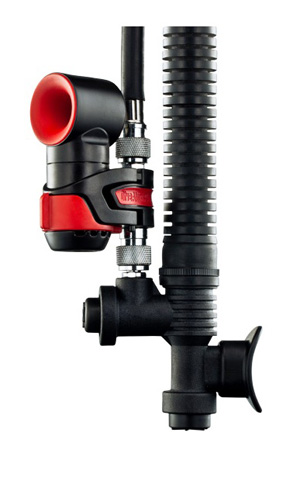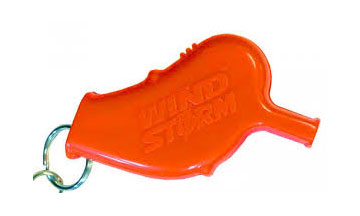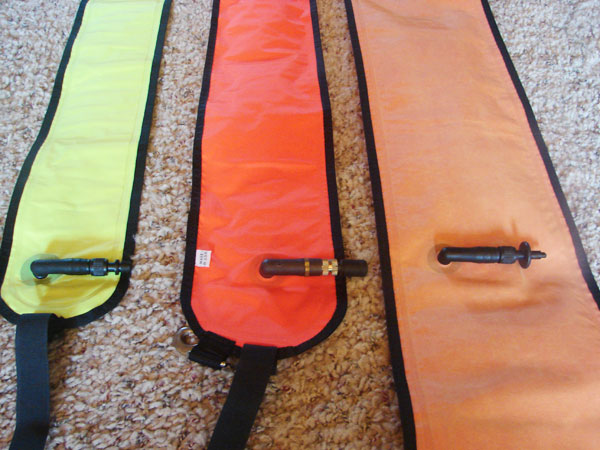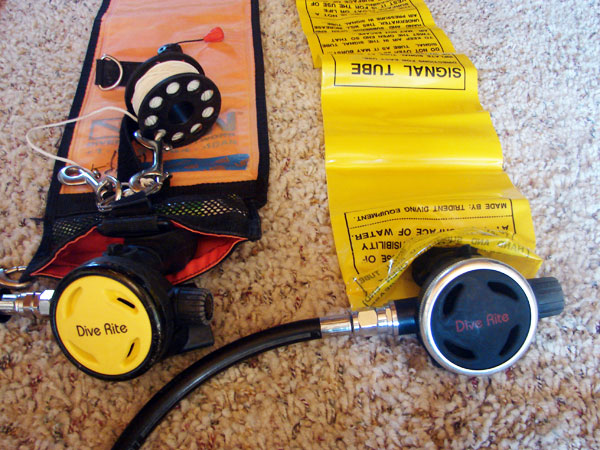A safety sausage is a buoy used when the diver is at the surface to indicate the diver’s position to the dive boat, reducing the risk of losing contact when air, light or sea conditions decrease the visibility of the divers from the boat. It is an essential piece of dive gear and should be something every diver carries with them on ALL dives. Having one with you on your dives can come in very handy, and possibly help save your life. It can also be another form of insurance, but none of this is valuable if you are not sure how to use it when the need arises.
Most articles and information out there help explain the different types of diver safety devices and how to choose which one might be the correct choice for you, but I think they are missing some vital information for you to make the correct decision.

The Dive Alert is an example of an audible safety system
There are 2 main types of safety devices in this category; audible and visible. An audible device would refer to something like a whistle or air horn. The air horn could be one you carry or one you would hook up to your low pressure hose that goes to the inflator for your buoyancy compensator – like a Dive Alert or something similar.
No matter which one you have, their operation is simple. You either blow into it or push a button to make a noise so others can hear and possible locate you. Of course the louder it is the better. My choice is a very loud whistle that works while wet and only needs your air to make it work.
Visible safety devices could be a mirror or safety sausage. Mirrors are also easy and simple to use. Just face the mirror towards the sun or other bright light to reflect that light to help show others where you are.
There are two similar devices of this type used to identify divers at the surface: Surface Marker Buoys and Safety Sausages. The primary difference between a Surface Marker Buoy (SMB) and safety sausage is that a SMB will typically be deployed from depth, whereas the safety sausage is deployed at the surface for signaling.
There are many types of safety sausages and they come in various lengths, colors, ways to inflate them. The big question is what type is best for you, and how bad do you want to be seen?
Some things to consider are: will you be diving warm water only, or both warm and cold? Will you be wearing thick or thin gloves? Do you like to bring up things like small anchors or are you just a sightseer? Will you be diving where it is flat and calm like a lake or in the ocean where there could be large swells and wind?

An inexpensive plastic whistle is a great safety device that’s easy to wear and use.
As far as lengths go, I think this is where size does count. Most safety sausages you can find are in lengths of 3’-6’, and for diving SoCal waters I wouldn’t want anything less than 6’. For the less than advanced diver, you might have never seen large seas while diving at protected places like Anacapa or Catalina, and you may never want to dive anything besides that and will think a 3’ tall safety sausage will be good. It could be, but the one time something out of the ordinary happens you will wish you had something taller. A safety sausage isn’t just so the boat can find you, but to show your position when other boaters are out having fun. If you are in large swells with wind chop it can also be hard to see a diver with a 3’ tall safety sausage.
The color of your safety sausages is also very important and you should have something visible from afar. I personally like the bright orange ones.
On one occasion, I drifted down most of the backside of Anacapa before being picked up by another dive boat. We were doing some drift diving, and there was a diver who the Coast Guard was coming to pick up off the boat I was drift diving from. There was no way they could pick us up until the chopper picked up the diver, leaving us in the water, drifting away. We drifted for about 45 minutes till the Spectre picked us up.
The construction of your safety sausage is also very important. Most safety sausages are made from a poly-urethane coated nylon material which is very durable and flexible, and can withstand the elements very well. I used what was called a Scuba Tuba for many years, which basically is a 6’ tall plastic bag that you inflated by placing your safe second stage facing up under it and pushing the purge button to add air into it. They work great (until you popped one) and we always carried spares.

There are different methods of inflating safety sausages and surface marker buoys.
One of the most overlooked items when people buy a safety sausage is how easy it is to inflate it. If you can’t inflate it, what good is it? I personally like the oral inflator on my DAN safety sausage, but whichever system you use, be sure to practice it on land before heading out to the water.
There are 2 main ways to inflate a safety sausage, depending on how it is constructed. Most of the smaller ones only have a plastic or metal stem that you must push open with your mouth to blow air into it. When you stop pushing it with your mouth, it seals the valve so the air stays inside, very similar to blowing up a beach ball or air mattress with the little flapper inside of it. The larger safety sausages usually have this method built into it, along with the bottom end being completely open so you can inflate by holding your safe second stage facing up while pushing the purge valve.

Be sure to practice inflating your safety sausage or SMB before you need it in an emergency
For me this method works the best, but takes a little getting used to. If you wait until you are on the surface and the safety sausage is laying down, it is hard to get the air to go up inside of it – you need to have the bottom lower to get the air into it. When drift diving, you learn how to do this just below the surface before completely surfacing, because the whole idea of using a safety sausage while drift diving is to warn others you might be in their way. I would much rather have my safety sausage ran over than myself. Remember, most boaters don’t even know what a divers flag is for!
Are you a warm or cold water diver? To me this is probably the most important question that is most often overlooked. I can tell you from experience that quite a few of the safety sausages you will find can be hard to use with a cold mouth and lips, and cold hands with gloves. Think about it, how many times do you come up from a dive in cold water and have a hard time just getting your gloves off? Now if that is the case how do you think you would even be able to operate the tiny inflators on some of the safety sausages? Add some rough seas and wind to the equation, and I think you get the full picture.
Now that you have plenty of things to think about, why not get your safety sausage out and get friendly with it so you will know just what to do when the time arises to use it!
Written by Ken Kollwitz
Ken is the owner of Channel Island Dive Adventures. Channel Islands Dive Adventures organizes and plans scuba trips (mainly charters) on various dive boats with four main goals in mind; to offer trips to specific unique dive destinations, to promote diver safety, to offer reasonable priced trips, and above all, to have fun with other like minded divers.
Channel Islands Dive Adventures also organizes and plans warm or cold water dive trips, diving/camping trips, Catalina Island trips and more. Please check the Channel Islands Dive Adventures event calendar for the current trips that are planned.
.
.
